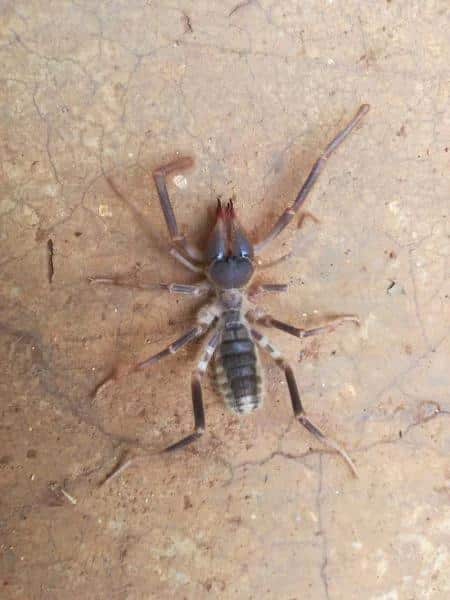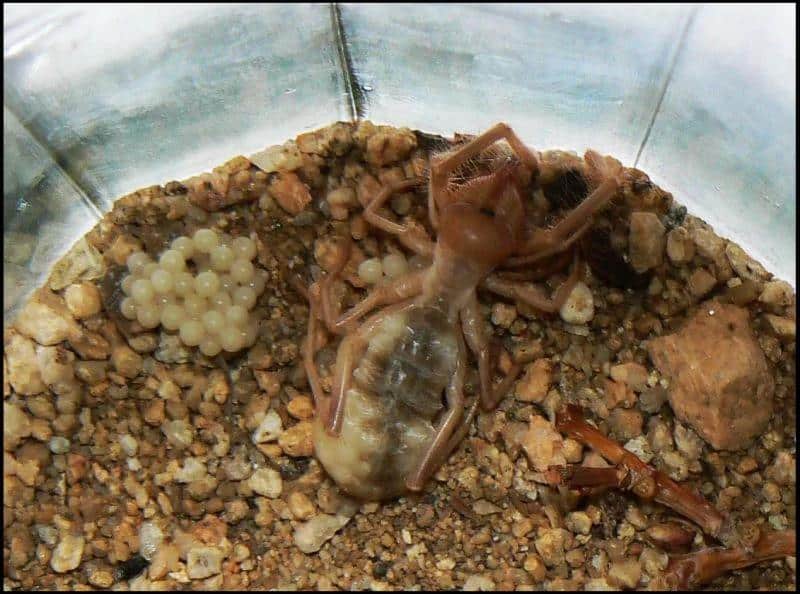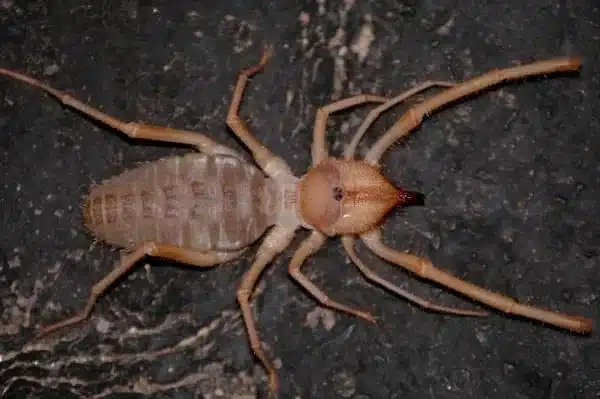Sun Spider Bite | Green Wave Pest Solutions Exterminators in Las Vegas
Home » Blog » Sun Spider Bite | Green Wave Pest Solutions Exterminators in Las Vegas
What is a brown recluse spider Sun Spider Bite
Sunspider (order Solifugae), formerly Solpugida, likewise spelled sun spider, likewise called sun scorpion, wind scorpion, or camel spider, any of over 1,000 varieties of the arthropod class Arachnida whose typical name refers to their habitation of warm, completely dry environments in addition to their characteristic gold color. As a result of their speed, they’re likewise called wind scorpions, camel spiders, and solpugids, after their scientific name. Their hairy opisthosoma (abdomen) and rounded opisthosoma (abdomen) mimic spiders, while their front appendages resemble scorpions. The body length varies from 10 to 50 mm (0.4 to 2 inches). Sunspiders are primarily on the move during the night.

Sunspiders are voracious eaters, with the biggest varieties with the ability of eliminating tiny vertebrates. The chelicerae (initial pair of appendages) are long toothed jawlike pincers, and the pedipalps (second pair of appendages) have suctorial pointers for capturing prey. The sensory malleoli (racket-shaped body organs) on the back legs may be sensory.
A sun spider bite is one of the most common, although painful, spider bites. A spider, specifically the red web spider, can cause excruciating pain if you are not careful. Many people who get sun spider bites may not even know that they have been bitten until it is too late. It is important to know what to look for and when to seek treatment so you can avoid complications.
Sun Spider Bite Symptoms
The first sign that you should look for if you think you have been bitten by a sun spider, or any other type of spider, is swelling. This is typically seen as a raised area on the skin that may feel warm to the touch. Other spider bites symptoms include itching and/or irritation around the bite area. It is also possible to feel a small pinch of venom injected into the skin, which will cause a burning sensation.
If you have been stung by a sun spider, the best thing to do is go to the doctor. The doctor will examine you and then take a sample of your skin for laboratory testing. The spider may be identified or the source of the bite will be identified. Your medical insurance company may cover the cost of the medical treatment provided you have obtained the proper medical treatment. In the case of a medical spider bite, most treatment is administered through local anesthetics. The anesthetic will make it possible for you to move around during the procedure, but will not prevent the spider from returning.
How long after a spider bite do symptoms occur?
Most people who are stung by the sun spider don’t seek medical treatment right away. They usually wait about two to four hours before seeking medical attention. This time can be very uncomfortable, so it is best to get treatment right away if you think you have been stung. Some people may choose to wait a few days or a week to seek medical treatment, but this is much more comfortable for them. After a sun spider bite, it can take about six weeks for the symptoms to disappear completely.

When does a spider bite need medical attention?
Many people who have sun spider bites report that the area around the bite looks red or irritated. A sun spider bite can appear as a raised bump or as a large, irritated swelling. If the bite is on the arm, the spider can make a small hole in the skin. The hole can become infected or inflamed. Many times, these wounds heal with the help of a bandage. The area around the wound may also become irritated, hot, and tender.

When to worry about a spider bite
Although it is possible to have an allergic reaction to the sun spider bites, this is usually rare. Usually, the symptoms caused by the bites are mild to moderate and will not typically require medical treatment. However, if it is discovered that you are allergic to spider bites, it is important to consult a physician as soon as possible. Spider bites can cause many serious health problems and treatments can eliminate them for good.
Other people are not allergic to sun spider bites and do not require medical assistance. In fact, the majority of people who become sick after sun spider bites simply stop scratching. This is because their bites only aggravate the skin and cause more itching, which leads to more scratching. Eventually, the affected area will begin to burn and a rash will develop. While there are no real dangers of sun spider bites, they should be avoided. Even if you only get a slight sun tan, the harmful rays from the sun could still cause serious damage if you have an allergic reaction.
Is a spider bite an emergency?
It is important to remember that most spider bite symptoms are non-specific and occur just as quickly as they occur. You will not know for sure what the cause of your rash or blister was until you visit your doctor to find out that you have a spider bite. Even if you do not have an allergy to spiders, you still need to seek medical attention as soon as possible. Only your doctor will be able to tell you with certainty whether or not you should take medical action following a spider bite.
These animals can be found throughout Las Vegas. They can be found in a selection of areas, including under stones, tree bark, and debris. The young travel on mom’s back like scorpions (Sun spiders are Solpugids, not spiders) (or solifugae).
Sun spiders have no venom and are completely harmless. They are one to 3 inches long, yellow to tan in color, and exceedingly bushy. Eight walking legs, long club-like pedipalps, and huge, muscular chelicerae differentiate them (jaws). The chelicerae’s tips are armed with 2 pairs of effective pincers. Several close-up photos can be found below. Sun spiders are voracious killers that move quickly. The front pair of legs, like vinegaroons, are utilized as feelers.
Camel spiders have actually long been represented in Middle Eastern folklore as substantial, poisonous killers with the ability of running as quickly as a human and with a voracious appetite for huge mammals. The tales are fraudulent. Although these spiders do not eat camel stomachs or sleeping soldiers, and they are not very significant, the real camel spider is still an awesome killer.
The past of camel spider false information begins with a misidentification. Camel killers aren’t spiders whatsoever. They come from the Arachnida class, much like spiders, yet they are solpugids.
Sun Spiders: Exactly How Do They Recreate?
Female sun spiders lay their eggs in a sand burrow. They will lay about fifty eggs and will fiercely guard them before they hatch out. If you happen to come across them, you’re in for a nasty bite. Sun spiders that are young are active during the night, while adults are active during the night yet quest during the day. Sun spiders only have a solitary generation every year.
These animals can be found throughout Las Vegas. They can be found in a selection of areas, including under stones, tree bark, and debris. The young travel on mom’s back like scorpions (Sun spiders are Solpugids, not spiders) (or solifugae).
Sun spiders have no venom and are completely harmless. They are one to 3 inches long, yellow to tan in color, and exceedingly bushy. Eight walking legs, long club-like pedipalps, and huge, muscular chelicerae differentiate them (jaws). The chelicerae’s tips are armed with 2 pairs of effective pincers. Several close-up photos can be found below. Sun spiders are voracious killers that move quickly. The front pair of legs, like vinegaroons, are utilized as feelers.
Camel Spiders In Las Vegas
Camel spiders have actually long been represented in Middle Eastern folklore as substantial, poisonous killers with the ability of running as quickly as a human and with a voracious appetite for huge mammals. The tales are fraudulent. Although these spiders do not eat camel stomachs or sleeping soldiers, and they are not very significant, the real camel spider is still an awesome killer.
The past of camel spider false information begins with a misidentification. Camel killers aren’t spiders whatsoever. They come from the Arachnida class, much like spiders, yet they are solpugids.

Sun Spiders: Exactly How Do They Recreate?
Female sun spiders lay their eggs in a sand burrow. They will lay about fifty eggs and will fiercely guard them before they hatch out. If you happen to come across them, you’re in for a nasty bite. Sun spiders that are young are active during the night, while adults are active during the night yet quest during the day. Sun spiders only have a solitary generation every year.



